Introduction
Phil Meyer began his 1991 book, “The New Precision Journalism,” an updated version of his seminal work introducing reporters to social science methods, with an observation that seems even more prescient today: “If you are a journalist, or thinking of becoming one, you may have already noticed this: They are raising the ante on what it takes to be a journalist.“1
While the ante is being raised, resources seem to be evaporating. Decreasing circulation and advertising revenues are leading management to ask more and more from their reporting and editing staffs. How do you deliver more? Embrace technology and use the power of the people to help with your reporting legwork. It makes newsgathering much more efficient if you can jumpstart the process of finding background, data, sources and experts.
To meet the increasing demands of editors, reporters need to become as efficient as possible. Through the use of technology and a more open approach to gathering information, reporters, photographers and editors can leverage their talent for newsgathering and news judgment without sacrificing their values. Capturing keystrokes to build useful databases (calendars, births, deaths, scores) and using new reporting methods such as crowdsourcing and distributed reporting are becoming the focus for more and more U.S. newsrooms.
Journalists are generally suspicious of new reporting methods. OK, this is actually one of the slowest professions to embrace change. A few decades ago, reporters were unsure about using quotes in a news story that came over the telephone, that newfangled gadget. In the 1990s, the same reservations surfaced when reporters began using e-mail.
… if you cut through the rhetoric, you’ll find unprecedented opportunities to do better journalism by embracing technology…. if you cut through the rhetoric, you’ll find unprecedented opportunities to do better journalism by embracing technology.
Today, despite the advances being made on news Web sites, there remains a general disdain for the new medium by many “traditional” journalists and a longing for the good old days before a fragmented media landscape made the job of capturing the audience’s attention so demanding. Today, everything from blogs to reader comments on a news Web site are sparking debate and causing traditionalists to sound many warnings. But if you cut through the rhetoric you’ll find unprecedented opportunities to do better journalism by embracing technology and transparency—two essential qualities for amplifying the important work of journalism in the digital age.
Spreadsheets and storing data
If you are a reporter and you don’t think you’re quite ready for blogging, RSS feeds, audio and video, you should apply the power of technology to your current endeavors. In short, you can become a better, more efficient reporter or editor simply by trading some of the paper-based information storage systems you’re currently using and going digital.
Stop using paper: If you are still using a Rolodex with little white cards to keep your contact list—STOP! This antiquated method is robbing you of precious time whenever you need to access a contact and is preventing you from storing more pertinent data on each of your contacts. Learn to use the contacts function in your e-mail program (Outlook or Entourage, for example) or, better yet, a spreadsheet program like Excel or Google’s free program (http://docs.google.com/).
Fielded data is a beautiful thing: When you set up a spreadsheet to compile lists (such as contacts), always try to include as many fields as possible. Fielded data is the key to sorting efficiently and being able to group items.
Mike Sando, the National Football League reporter at The News Tribune in Tacoma, Wash., uses fielded data as well as anyone. He tracks every stat of every game he covers in Excel and then sorts the data to answer virtually any question, and posts the results on his blog. For example, below is an analysis of the Seattle Seahawks’ performance on third down at one point during the 2006 season.
Sando sits with dozens of football writers each week who cover the same games he does. While they use pen and paper and elaborate grids to track the game’s proceedings (or worse, rely on the teams’ media handouts), Sando builds spreadsheets (on his laptop computer) with important data as each play occurs. His colleagues, meanwhile, are creating a temporary resource that will help them write a game story but will be of little use as the season progresses.
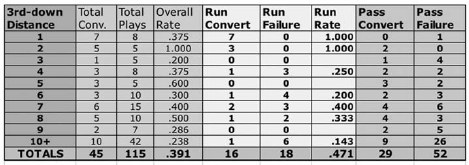
More examples: For other kinds of sample data files that might be useful in news reporting, go to http://powerreporting.com/files/index.html.
Here’s how another example of data collection, sorted into a fielded spreadsheet, becomes a powerful display of information. This one charts grocery prices in Chicago suburbs.
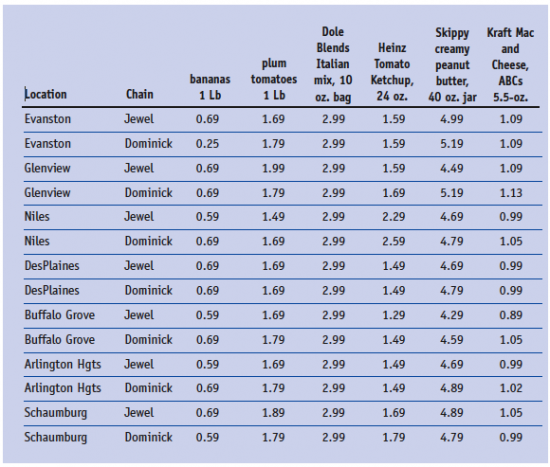
Where data can thrive: Some newspapers are making their Web sites “data destinations,” and well they should. Computer-assisted reporting has been around for decades but, restricted to the newspaper format, it can’t realize its full potential. On the Web it can sing, with depth, customization, searchability and a long shelflife. USA Today realized this years ago when it began loading the salaries of professional baseball, football, basketball and hockey players into searchable databases (http://usatoday30.usatoday.com/sports/salaries/index.htm). Other newspapers, such as the Louisville Courier-Journal, collect their databases in one area on their Web sites (http://www.courier-journal.com/section/DATA/Data-Center).
Your ‘so-called digital life’
If your company doesn’t provide a slick, simple-to-use tool for capturing notes, lists and calendar items, use a free Web service like Backpack (backpackit.com). This will enable you to manage your time by adding meetings and appointments to a calendar while simultaneously managing a to-do list. You can access it from anywhere via the Web and even share it with others in your newsroom. An electronic system like this is better than paper because it’s easy to edit and modify lists, change the order or priority, and store your calendar items and lists as an archive.
If you can, use a database: At the Ventura County Star, Howard Owens built a database for news sources and set it up so that all the reporters could share it over the Web. “All source information was stored there and was accessible by the entire newsroom,” Owens said.
Many newsrooms have set up similar databases, but not enough of them. Ideally, it would store a source name and contact information, background information and the file name and location of a mug shot if one exists. It should contain personal information such as birthday (for age purposes), spouse, children, title and affiliation. Affiliations (school, business, agency) can be stored in a separate table so they could be entered once and related to a source. Then anyone in the newsroom can search by name, specialty or agency.
As more journalists go digital it will make it easier to share information. Derek Willis of The Washington Post wrote in the first of his series of essays on his blog “humbly titled Fixing Journalism”: “Can you imagine another information-based business that permitted its employees to build walls around their information? Can you imagine it succeeding today?” (Read the entire series at http://blog.thescoop.org/thefix/.)
Think of all the information that passes through a news organization every day. Now think how little of it is accessible to those who work there, or more importantly, to the public who would like to access it. This is a problem for news organizations going forward. And it needs to be fixed now. You can start by storing your information electronically and pushing for data-sharing tools like internal wikis and shared databases.
Event calendars are the obvious place to start in your newsroom. If staffers are still entering each event by typing it into a Word document, you have a problem. If you had a database, such information as venue name, address and phone number would only have to be entered once, thereby cutting the workload (and the chance for typos).
There are many other opportunities where keystroking is being repeated year after year in flat files that aren’t searchable or sortable by the audience. Here’s a few areas we’re databasing (or planning to) in Tacoma:
- Summer camps lists.
- Sports team tryouts and camps.
- Restaurant and movie listings.
- Vital statistics (births, deaths, divorces).
- New businesses and business hires and promotions.
- Hike of the week.
- Guide to local ski areas.
Each of these types of content has been entered by newsroom staff for years, if not decades. We can maximize the value of the data by providing it to our audience in a database format while streamlining our own operation and cutting down on the amount of data entry we do.
Can you database news coverage?
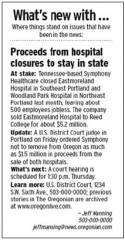
An example of an Update Box from The Oregonian.
Yes, you can. Many newspapers have adopted the “alternate story form” for basic news coverage, where a narrative is broken apart into easily digestible chunks with labels like “what happened,” “what it means” and “what’s next.” The Oregonian in Portland has standardized its meeting and process coverage with “update boxes.” This new story form, with labels like “At Stake,” “Update,” “What’s Next,” and “Learn More,” means the data is already being published in consistent fields that could be easily converted to a database.
Think of city council or school board meeting coverage. If you had a database that stored all the pertinent data (date of the meeting, top agenda items with a quick summary for each, the votes and maybe a field for analysis) you could pull from this to populate such an alternative story form for the print edition. Online, the audience (and your reporters) would be
able to search and sort previous meetings.
Crowdsourcing
As discussed in Chapter 2, the concept of Web 2.0 sees the Internet as allowing enthusiastic communities to come together and provide more value for a given Web site. Crowdsourcing focuses that community power on a specific project and demonstrates how a large group of committed individuals can outperform a small group of experienced (and paid) professionals. The online version of Encyclopedia Britannica, for example, cannot keep up with Wikipedia in terms of updating articles and information. And Microsoft, with all its resources, has struggled to keep pace with the development of the Firefox browser, a project powered by volunteers collaborating together under the nonprofit Mozilla Foundation.
Crowdsourcing is a relatively new term, coined by Jeff Howe in a 2006 article for Wired News.2 It is very similar to “distributed,” “collaborative” or “open-source” reporting and many people use the terms interchangeably. To distinguish between the concepts, think of crowdsourcing like outsourcing, the term from which it was born. The focus of crowdsourcing is usually ongoing production of information while distributed reporting relates more closely to a specific and fixed-time project, such as answering a specific question or reporting on a specific subject. Voting irregularities, then, would be a form of distributed reporting since the need would be reporting for a timely news story.
But don’t get frustrated by the terminology. This is all very fluid and rapidly developing. It’s the concepts that are important.
In the summer of 2006, The News-Press in Fort Myers, Fla., asked for readers to help in the investigation of ongoing concerns over rising utility bills. The audience responded in surprising numbers and supplied the reporting that became the story. The newspaper was caught off guard by the initial flood of calls and e-mails.
“The story built itself,” News-Press editor Kate Marymont said. “The public shaped it and we had to get used to that. We had to learn that online development of a story and the development of a print story take different paths.”
Crowdsourcing harnesses the power of community on a continuing basis to improve a service or information base. When we built an online map plotting all the places in our coverage area to go for free wireless Internet access, The News Tribune then asked the public to submit locations that we missed or that have since opened. We also invited them to comment on the locations and add photos, enhancing the original service. In the first six months, dozens of readers have contributed.
The concept of crowdsourcing might seem to lend itself especially well to grassroots organizations and projects. But some of the most notable examples of crowdsourcing have come from some very big companies, including Procter & Gamble, Amazon and Google. Following are some examples:
- Procter & Gamble launched a Web site called InnoCentive offering serious cash rewards to more than 90,000 freelance scientists who could solve problems that the company’s 9,000 scientists couldn’t. It now works with other companies as a sort of crowdsourcing broker, allowing them to use the site to solve problems of their own. www.innocentive.com
- Amazon.com describes its Mechanical Turk project as “Artificial Artificial Intelligence.” It pays people to complete tasks that people do better than computers, such as identifying subjects in photographs and translating text. This is the opposite of the InnoCentive project. The pay is low and the tasks can be done by anyone. People need to perform a high volume of tasks to make any real money, but the tasks are so simple that some 10,000 people have registered to “turk.” www.mturk.com
- Google doesn’t pay people to participate in its Image Labeler program, but it made the exercise so fun that it can be addicting. The goal is to improve the quality of Google’s Image search. Over a 90-second period, you are shown random images and asked to provide as many labels as possible. You “play” with another random user and when the two of you agree on a label, the software gets smarter. http://images.google.com/imagelabeler/
Distributed, collaborative or open-source reporting
The concept of distributed reporting is a form of transparency for a news organization. Traditionally, readers only learn about stories a news organization is working on when the articles are finished and published. While it is customary to keep a story idea secret to prevent the competition from running with the idea, the distributed reporting model requires a news organization to go public with a story idea early in the reporting process.
The reason? To allow readers to assist in the reporting of the story.
In December 2006, The Cincinnati Enquirer tapped the power of distributed reporting to gauge compliance with a new smoking ban. Here’s how the paper’s investigative and enterprise reporter, Gregory Korte, described it in his blog:
“Whether you’re a smoker or non-smoker, you probably want to know which bars, restaurants and bowling alleys are complying with Ohio’s new ban on smoking—and which are ignoring it until the state posts new regulations.
And we’d like to tell you. But with 1,488 bars and restaurants in Hamilton County alone (that’s just counting the liquor licenses), it’s hard to get around to all of them.
It’s a good example of why The Enquirer, like all Gannett newspapers, is embarking on an experiment in what we call ‘crowdsourcing.’ We’re asking you to help us report the story by telling us what’s going on in all those places we can’t get to.”
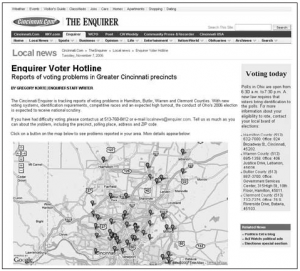 During the 2006 Elections, The Cincinnati Enquirer invited readers to report voting problems they experienced at their polling places. Dozens of readers called or e-mailed to describe the irregularities andThe Enquirer presented the problems on a Google Map on its Web site (http://www.cincinnatidatadesk.com/pages/voter.html).
During the 2006 Elections, The Cincinnati Enquirer invited readers to report voting problems they experienced at their polling places. Dozens of readers called or e-mailed to describe the irregularities andThe Enquirer presented the problems on a Google Map on its Web site (http://www.cincinnatidatadesk.com/pages/voter.html).
While the terms used to describe it are new, the practice itself has been around for many years. The Spokesman-Review in Spokane, Wash., began using distributed reporting in 2001 with a database of e-mail addresses—something it called a “reader network”—to correspond with readers while reporting stories. This model has been copied by newspapers everywhere and used effectively in many situations, especially when looking for sources to interview on a specific topic or feedback or reaction to a current issue in the news.
Most reader networks were started with e-mail addresses from readers who had contacted the newspaper, either by sending a letter to the editor or asking a reporter about a news story. Through its Web site, a news organization can also build the database by advertising the network and inviting readers to join.
Minnesota Public Radio excels at this with its Public Insight Journalism initiative (http://minnesota.publicradio.org/your_voice/). By collecting as much information as possible, the news organization can slice the network several different ways and target specific subsets of the list for certain queries. People who live in a particular ZIP code, for example, or sports fans.
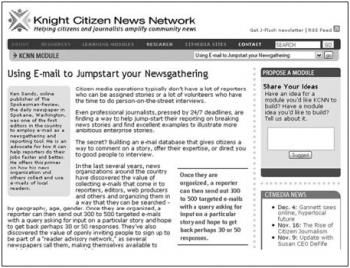
For more examples of how to use an e-mail database for distributed reporting, see Ken Sands’ article.
Ken Sands, who pioneered the practice in Spokane, highlights two ways the use of an e-mail network differs from traditional audience feedback such as letters to the editor or person-on-the-street interviews.
“One, the interaction occurs before publication, during the information-gathering process; and, two, by actively reaching out to people, you get a different, broader reaction than you do by waiting for people who are compelled by passion to contact you,” Sands wrote for the Knight Citizen News Network.
Some newspapers now have more than one reader network. It can make sense to create and manage separate contact databases for education stories (if you need direct contact to teachers) or business stories (if you need to get feedback from local business leaders only).
The concept is going national (and/or global) too. In 2006, New York University professor Jay Rosen and others launched NewAssignment.net, a sort of clearinghouse for open-source reporting projects produced by teams of volunteers. Craig Newmark (of craigslist fame) contributed $10,000 to help launch the project.
“In this sense it’s not like donating to your local NPR station, because your local NPR station says, ‘Thank you very much, our professionals will take it from here.’ And they do that very well,” Rosen wrote on his blog PressThink. “NewAssignment says: Here’s the story so far. We’ve collected a lot of good information. Add your knowledge and make it better. Add money and make it happen. Work with us if you know things we don’t.”
At a time when news organizations are looking for ways to build brand loyalty, getting readers and viewers to participate in the news process can help.
Summary
As you probably are painfully aware, very few, if any, news organizations are adding to their staffing levels these days. That doesn’t mean that journalism is any less important than it used to be. It means that journalists need to find new tools and efficiencies to continue their important work and even take it to a higher level.
“We need to get out of the keystroke business,” says Don Nelson, executive editor of the Skagit Valley Herald in Mount Vernon, Wash.
You need to leverage existing resources. Storing data electronically is a good place to start. Finding ways to incorporate crowdsourcing in your reporting will help, too.
Assignment:
- Convert your contacts to an electronic form.
- Ask a managing editor about a shared newsroom database for contacts.
- Identify a story you’ve done, or one you’ve read recently, that would have benefited from crowdsourcing or distributed reporting.
1. Philip Meyer, The New Precision Journalism, 2nd Ed., Indiana University Press, 1991. Philip Meyer is the Knight Chair in Journalism at the University of North Carolina at Chapel Hill. This is an updated version of Meyer’s 1973 book, “Precision Journalism: A Reporter’s Introduction to Social Science Methods.”
2. Jeff Howe, “The Rise of Crowdsourcing,” Wired Magazine, June 2006. Jeff Howe covers the entertainment industry as a contributing editor for Wired Magazine.
